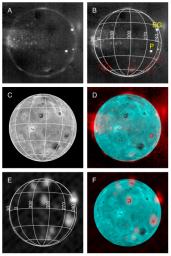New Horizons took this montage of images of Jupiter's volcanic moon Io, glowing in the dark of Jupiter's shadow, as the Pluto-bound spacecraft sped through the Jupiter system on Feb. 27, 2007.
(A): In this picture from the Long-Range Reconnaissance Imager (LORRI), dark blotches and straight lines are artifacts. The brightest spots (including the volcanoes Pele [P] and East Girru [EG]) are incandescent lava from active volcanoes. The more diffuse glows, and the many faint spots, are from gas in the plumes and atmosphere, glowing due to bombardment by plasma in Jupiter's magnetosphere, in a display similar to the Earth's aurorae. (B): The same image with a latitude/longitude grid, showing that the cluster of faint spots is centered near longitude 0 degrees, the point on Io that faces Jupiter. The image also shows the locations of the plumes seen in sunlit images (indicated by red diamonds), which glow with auroral emission in eclipse. (C): Simulated sunlit view of Io with the same geometry, based on sunlit LORRI images. (D): A combination of the sunlit image (in cyan) and the eclipse image (in red), showing that all point-like glows in the eclipse image arise from dark volcanoes in the eclipse image. (E): This infrared image, at a wavelength of 2.3 microns, obtained by New Horizons Linear Etalon Spectral Imaging Array (LEISA) an hour after the LORRI image, showing thermal emission from active volcanoes. Elongation of the hot spots is an artifact. (F): Combined visible albedo (cyan) and LEISA thermal emission (red) image, showing the sources of the volcanic emission. That most of the faint point-like glows near longitude zero, seen in visible light in images A, B, and D, do not appear in the infrared view of volcanic heat radiation, is one reason scientists believe that these glows are due to auroral emission, not heat radiation.
This image appears in the Oct. 12, 2007, issue of Science magazine, in a paper by John Spencer, et al.

 Planetary Data System
Planetary Data System












